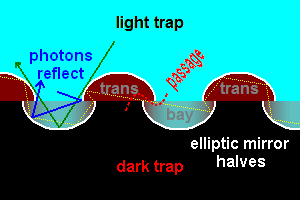 Black hole fence:
Black hole fence:| A window that blocks sunlight but not daylight; A sundial with signs and seasons, months, days, hours, minutes, in digital if you like; An open entryway that keeps light and sound, out and in and trans... All true: Inventions on a theme of sunbeams... |
Extending that to its generality---
A window pane with one side a 50% "random" mask (random being any discrete pointillation [pixelation] function having fairly small-scale near-uniform obscuration density of 50% at all angles of view), and the opposite side a high-contrast photochromic sheet, can effectively block intense sunlight beams: each beam filament strafing through the mask thence actuating the photochromic darkening response in its corresponding point on the far side: thus blocking itself---while less intense light at other angles does not so actuate the photochromochemical response: therefor passing through uninhibited (albeit reduced by the total average double-masking to 25%).
In the specific case of sunbeams which on a clear day spread 0.009 rad (0.5 deg=0.6 grad) the pane must be much thinner than 1.000/0.009 the average pointillation mesh size, while the mesh size is lower bounded by optical diffraction, to be overall effectual. Which for the typical sun-relieved occular pupil 3-5 mm, limits window thickness below 10 cm (1 mm mesh) and mesh above 0.01 mm (10x red photon wavelength)---a fair range of standard utility window-thin thickness, 1 mm to 10 cm. NB: If designed for interplanetary use nearer the sun (where it would be more needed) the angular constraint is tighter.
For suntrap glasses, the photochromic electrochemistry must be extremely fast-acting, else each slight movement results in apparent sunburst "solarization".
More practical applications (for slower photochromochemistry) might include "skylight" and southern exposure "picture" windows on homes, employment facilities, space-station Earth-presence windows, vehicle windshields, cars, trucks, aircraft and space-shuttles (the latter being the original intent in design).
Aside the advantage of sunbeam-blocking, suntrap windows may offer advantage against the glare of night-use vehicle headbeams---both stationary and moving. And in special applications may also offer collateral advantage against white-out conditions where the photochromochemistry can be so selected to lesser-responsed obscuration.
Final details to consider in application, are that surrounding any bright source in view is it's penumbra, by angle about the ratio of window thickness to mesh---thus a thicker suntrap is preferred, to minimize the penumbral detilieration of the image.
[detilieration: the manual painting technique of applying cropped overlayers of dark
film "tiles" to effect apparent shadows; in lieu of mixing darker paints]
[pointillation: the manual painting technique of applying points of paint, in lieu of
brush strokes, to compose a larger image---(cf color video pixelation)]
Its alignment is technically challenging for precision and accuracy---and months do crossover (slightly summerward in the northern hemisphere---an asymmetry due to combined sun-Earth distance and Earth inclination to the ecliptic [apparent sun-path plane]---the relatively slight lesser difference in distance at latitudes may be insignificant compared to overall sun-Earth distance in this particular application).
 Black hole fence:
Black hole fence:A useful wall construction blocking the passage of light and sound, seeing and hearing, but not persons and airflow, things straight-ballistic but not things turn-controlled, -and is itself-not dark,- is a mirrored entrance that reflects -all- light back to the same side it comes... the bidirectional equivalence of mirroring isolates all light from the other side, and as well that inside, the wall... sort of a tri-ambi/'amtri'/'antri'-trap, light-rift....
Solving the equation for a ballpark fence opening allowing players but not balls through, and applying it to light as well, simplifies to requiring balls from one end-post of the fence-opening to reflect to the opposite next end-post;-- balls in-between reflect back-in-between and thus all balls entering are entrained to leave the same side... An equation is the long-side half ellipse with its end-posts at adjacent foci. This is then chained alternately-in-out-half-ellipses convex mirrored (one in-or-out-side mirrored, suffices: its unused and convex sides may be decorative). The 'ideal' focal-spread allows two-or-more persons side-by-side-or-passing entering/exiting i.e. e ≥ (f=1)/(a=2) = 0.5.
Persons can then enter between the end-posts and turn about an 'S' to exit past the end-post set of the adjacent counter side.
(It is also noteworthy that the mirror bays are cross-traps: A ball thrown as-not-out from any mirror bay reaches the next and successively other mirror bays, chaining-along.)
Practical uses, include, theater foyer-exits, veranda walls, light-efficient open connected halls, by floor-to-ceiling colonnades; fences, LiD-fusion chambers,... needing keeping straight-ballistic objects, light, radiant-heat, sound, balls, atoms, in or out without obstructing passage; Cross-trapping uses include transitioning prep-light-and-sound e.g. accustoming red/annunciating 'welcome to the darkroom'...
(Comparative note: From the ellipse here-used to create a "black hole" in a fence, comes the same equation for one early construction of the hydrogen fusion-detonation device, focusing the output of a fission-detonation device placed at one focus of an ellipsoid, onto a fusion core placed at the other. [There are numerous more constructions])
Such construction, blocks sound fairly well, and light verily well, but wave action allows refractions around edges and corners... still, useful, for theaters, operations-rooms, etc.
A premise discovery under the title,